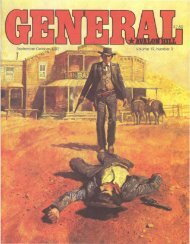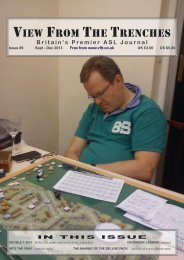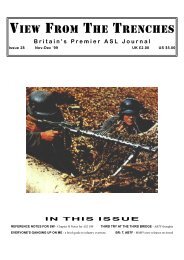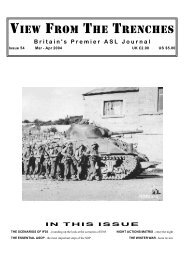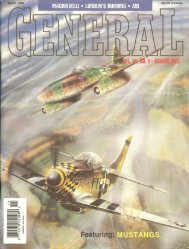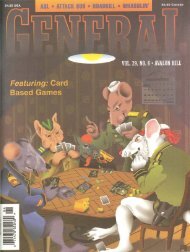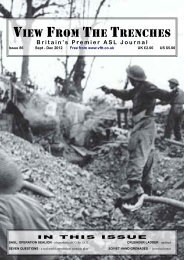18.64MB - View From The Trenches
18.64MB - View From The Trenches
18.64MB - View From The Trenches
- TAGS
- trenches
- www.vftt.co.uk
Create successful ePaper yourself
Turn your PDF publications into a flip-book with our unique Google optimized e-Paper software.
15, No. 2 and although controversial, represented<br />
an innovative attempt to find new and unexplored<br />
lines of strategy.<br />
<strong>The</strong> "Air Power" plan was as follows: Soryu,<br />
Hiryu, Ryujo, and Zuiho would be alone in the<br />
Raid Force (since no followup strike would be<br />
possible in the face of US carrier opposition, no<br />
surface escort was assigned). <strong>The</strong> remaining<br />
carriers were to go to the Central Pacific along<br />
with a surface contingent of at least six cruisers<br />
and the six slow battleships.<br />
<strong>The</strong> Pearl Harbor raid was to focus on the two<br />
cruisers and the 7th AF, and leave the US carriers<br />
to the I-boat. This left the remainder of the fleet<br />
unmentioned: four battleships, 14 assorted<br />
cruisers, and six LBA units; presumably these<br />
would deal with the remaining five Allied cruisers<br />
and the Indonesia forces.<br />
<strong>The</strong> rationale? <strong>The</strong> US battleships in Pearl<br />
aren't much good without LBA and carrier air<br />
factors to back them up, so concentrating on the<br />
7th AF and the carriers is supposedly preferable.<br />
However, despite a 51% chance at the US forces in<br />
the Central Pacific, there is a much greater chance<br />
to hit most of it in Hawaiian waters (if it stays) and<br />
a 100% chance to sink battleships that, although<br />
of little use on their own, could be critical in a<br />
general fleet action.<br />
<strong>The</strong> plan's advocacy of priority strikes on 7th<br />
AF, San Francisco, and New Orleans, means that<br />
the US, at worst, loses two cruisers and an air unit<br />
(the latter only temporarily). Not a bad trade for<br />
eight battleships. Meanwhile, the IJN carriers go<br />
for fringe units.<br />
<strong>The</strong> upshot of this plan is that redundant forces<br />
are used in the Central Pacific and elsewhere,<br />
while the advantage of the Pearl Harbor strike is<br />
tossed aside. Worst of all, and the reason that this<br />
plan is cited, is that this plan represents an abject<br />
surrender to Lady Luck. This is reminiscent of the<br />
winner-take-all 2-1 on Tobruk or the Quatre Bras<br />
heights, also sometimes advocated in this<br />
magazine. Such a policy could pay off spec-<br />
tacularly, but places reliance on chance rather than<br />
reasoning power.<br />
And that is the object lesson of "Air Power in<br />
the Pacific," which transcends any one game.<br />
Luck is a two-edged sword-swing it often<br />
enough, and hard enough, and you're apt to cut<br />
your own head off.<br />
CRITICAL ISSUE #6: Turn Two<br />
<strong>The</strong> second turn sees Allied forces vastly out-<br />
numbered. <strong>The</strong> Allies do have some advantages,<br />
though, in this first turn of unencumbered move-<br />
ment. Thanks to the turn sequence, the Allied<br />
player need not lose any raiding ships unless<br />
tempted to stand up to superior enemy raid or<br />
patrol forces. Such temptations include a last ditch<br />
defense of Hawaii, Ceylon, or Samoa, at<br />
dangerous risk.<br />
Still, if the Allied player wants to be able to<br />
choose between fighting or running, then Allied<br />
carriers and battleships had better be raiding.<br />
Allied raiders move last and, although not able to<br />
gain POC, can pounce on weak IJN forces and<br />
affect the general course of play. Attrition is of<br />
paramount importance, as Allied strength, or lack<br />
of it, will determine IJN gains, as much by in-<br />
timidation as by force.<br />
A deadly stratagem in early IJN moves is to<br />
make the American player feel compelled to stand<br />
up for a critical area (Hawaii or the US Mandate,<br />
among others), or worse, divide US forces. US<br />
players take warning: That is precisely what the<br />
enemy wants. A particularly nasty example is Alan<br />
Moon's "TKO" strategy (Vol. 17, No. 4), which<br />
envisioned US forces compelled to make a gallant,<br />
and futile, last stand at Hawaii or Samoa.<br />
CHART I. THREE OPENINGS<br />
3. Marine deployment optional unless specified.<br />
Ed O'Connor's "Maniacal Approach" (Vol.<br />
17, No. 6), rebutted "TKO"; no additional com-<br />
ments on tactics are necessary. Still, the main,<br />
diabolical theme of "TKO" and other IJN<br />
strategies remains: Compelling the Allies to defend<br />
that which cannot be defended. <strong>The</strong> only answer is<br />
to stay out of harm's way and not play on the<br />
enemy's terms.<br />
If the IJN wants geography, they will have it<br />
during the early turns, like it or not. <strong>The</strong> Allied<br />
player should mass what little force is available,<br />
building around the five US carriers, and wait for<br />
an opportunity. Such an opportunity, involving a<br />
massed US raid on part of the IJN, will be worth-<br />
while only if the US is strong enough to inflict<br />
heavier losses than it takes.<br />
Above all else, remember that the turn<br />
sequence usually allows the Allied player to fight<br />
where he chooses, and not where it suits the<br />
enemy.<br />
Three ports are critical on Turn Two. Truk, of<br />
course, is adjacent to three areas at once, and dead<br />
center on the board. Truk is a central position<br />
dominating scattered Allied enclaves all around the<br />
board-edge, compensating the IJN somewhat for<br />
its turn sequence disadvantage. Whether operating<br />
as scattered forces, or en masse, the IJN should<br />
base almost exclusively at Truk.<br />
Australia can serve as an excellent US base,<br />
and as an alternative to a threatened Pearl Harbor.<br />
<strong>The</strong> main advantage: If the IJN can be pushed out<br />
of Indonesia, Australia can be the springboard for<br />
the US part of the effort. Loss of IJN control in<br />
Indonesia means that, besides a major loss of<br />
POC, the IJN siege of Singapore is broken. <strong>The</strong><br />
relief of Singapore in turn can allow the Royal<br />
Navy a forward base.<br />
Further, Australia can provide a better base for<br />
American battleships. Slow as they are, US battle<br />
units can raid Indonesia or the South Pacific from<br />
Australia. Rather than basing at Pearl, among less<br />
lucrative areas, Australia puts the US battle line<br />
squarely into the fight, able to contest large POC<br />
areas with the Tokyo Express.<br />
Samoa may serve as an alternative US base, if<br />
the US has to withdraw from Pearl on Turn One.<br />
Ships based in Samoa can reach the Hawaiian<br />
Islands and the Coral Sea easily. Australia is still<br />
preferable for combined operations with the<br />
British-especially for defending Ceylon-but<br />
carrier task forces in Samoa can reach all the way<br />
from Ceylon to the North and Central Pacific. A<br />
One 1-0-7<br />
Marianas Japanese Aleutian<br />
Two 4-4-4 Tw<br />
massed force of five carriers and 15 cruisers on<br />
raid status can be kept as a dangled threat to every<br />
IJN probe, forcing a narrowing of the enemy<br />
effort, and only control of the the US Mandate<br />
could enable the IJN to hamper this which, in<br />
turn, would only cause the US to base elsewhere.<br />
Some Allied tactics for Turn Two, and after-<br />
ward:<br />
1. Avoid battle unless locally superior. A<br />
strong force can crush a small one with little loss,<br />
but an even fight will cost the US more than it can<br />
afford. A few CVs and their cruiser escort must<br />
last till Turn Five.<br />
2. Raid into enemy territory where possible.<br />
Go where the main IJN fleet isn't, and cut into<br />
their POC. It will do the IJN little good to raid the<br />
US Mandate if US ships are visiting the South<br />
Pacific or the Marshalls. Be prepared to take on<br />
LBA, if you're so inclined, with lopsided air<br />
superiority on the order of 4:l or better.<br />
3. Put US LBA units in the danger spots:<br />
Coral Sea, the Mandate, Hawaii, wherever raiding<br />
IJN carriers are likely to go. For control of US rear<br />
areas, LBA units are preferable to surface patrols.<br />
LBA can be replaced, and can take out enemy<br />
carriers; surface ships usually can't do either.<br />
4. Start levering the IJN out of forward areas,<br />
using the Marines. Crucial bases like Guadalcanal,<br />
Midway, Lae, and Dutch Harbor can prove impor-<br />
tant once US LBA units become available.<br />
This Critical Issue is somewhat general. Any<br />
strategy cannot take the enemy for granted, and<br />
only general maxims can be used. <strong>The</strong> Allied<br />
player must live through the first four turns by<br />
flexibility and resourceful use of what few assets<br />
are at hand.<br />
As for strategy late in the game, after the tide<br />
has turned: <strong>The</strong> course of play for the entire game<br />
will be determined by the first two or three turns.<br />
CRITICAL ISSUE #7:<br />
<strong>The</strong> Pearl Harbor Gambit<br />
SAN FRANCISCO (AP1)-<strong>The</strong> surrender of U.S.<br />
forces on the embattled island of Oahu was announced<br />
today by their commander, Maj. Gen. Robert L.<br />
Eichelberger, in a radio broadcast monitored here.<br />
Gen. Eichelberger, who replaced Gen. Douglas<br />
MacArthur after the latter's escape in July, called upon<br />
US forces still holding out in the Hawaiian Islands to halt<br />
further resistance.<br />
<strong>The</strong> surrender ceremony, transmitted from Adm.<br />
Yamamoto's headquarters in Honolulu, marks the end of<br />
an epic nine-month naval siege.



